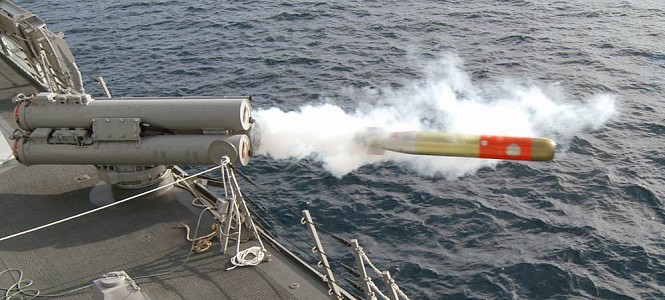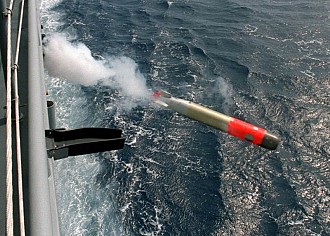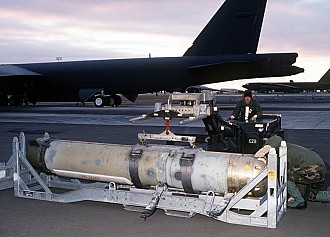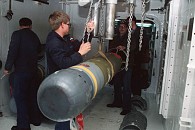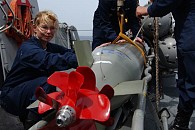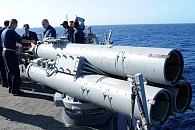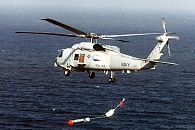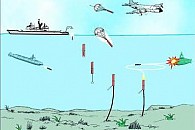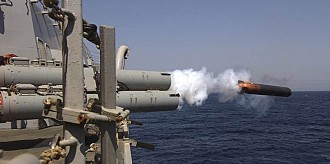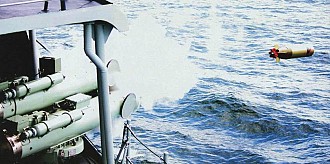General Facts
- TYPE
Lightweight torpedo - ORIGIN
 United States
United States - NICKNAMES
NEARTIP (improvement program) - DESIGNED
1960 - 1963 - DESIGNER
Aerojet-General - PRODUCTION
1966 - 1987 - PRODUCERS
 Japan - Mitsubishi (Mod 5)
Japan - Mitsubishi (Mod 5)
 United States - Aerojet-General (Mod 0)
United States - Aerojet-General (Mod 0)
 United States - Alliant Techsystems (CAPTOR mine)
United States - Alliant Techsystems (CAPTOR mine)
 United States - Honeywell (main producer)
United States - Honeywell (main producer) - QUANTITY
Over 26.000 Mk 46 produced, including:
6.608 Mod 1
3.344 Mod 2
4.922 NEARTIP upgrade kits
6.058 Mod 5 - UNIT COST
Unknown - CHARACTERISTICS
 Good speed and range
Good speed and range
 Powerful warhead for lightweight torpedo
Powerful warhead for lightweight torpedo
 Dedicated shallow water upgrades
Dedicated shallow water upgrades
 Can be launched from many platforms
Can be launched from many platforms
 Complex design and expensive
Complex design and expensive
Introduction
The Mk 46 is a lightweight torpedo of US origin. It was developed in the early 1960's to replace the successful Mk 44 torpedo. It was the first high performance thermal powered torpedo in US service. The complex but powerful propulsion system was chosen to keep up with Soviet submarine developments. The Mk 46 is the most common lightweight torpedo in the world and remains in widespread use.
Layout
The Mk 46 has a conventional layout with the homing section and warhead in the nose, the fuel in the middle and the engine and control fins at the rear. Apart from the original production version all Mk 46 use an Otto fuel engine. Over time the design was improved with improved guidance, stronger body, new fuel and two speed engine.
Guidance
The Mk 46 uses a passive and active sonar guidance system. Over time the quality of the seeker has been improved. The seeker on the Mk 46 Mod 2 reportedly has a detection range of 460 meters. The latest models received various upgrades to improve performance in shallow water.
Firepower
The Mk 46 has a range of 8 km and a speed of 40 to 45 kt. The NEARTIP improvement includes a two speed motor which extends the range up to 11 km. The Mk 46 can engage targets ranging from 15 to over 400 meters below sea level. The 45 kg warhead is more powerful than those used on many other lightweight torpedoes.
Launch platform
The Mk 46 is found on many surface vessels ranging from frigates to cruisers. The Mk 46 can also be air launched and is used on various helicopters such as the SH-60 Seahawk, the Sea King and the Lynx. The Mk 46 is also deployed by more unconventional means such as the Mk 60 CAPTOR mine and ASROC anti-submarine rocket.
Users
The main user of the Mk 46 is the US navy. Subsequent upgrades ensure that the Mk 46 remains a capable weapon, although the very latest lightweight torpedo designs feature both better guidance and propulsion. The Mk 46 is in use with many NATO partners and various other US allies, making it the most numerous lightweight torpedo in the world.
Mk 46 torpedo
Mk 46 Mod 0: Original production version with unreliable solid fuel turbine motor introduced in 1963.
Mk 46 Mod 1: Extensively upgraded Mod 0 with original engine replaced by Otto fuel engine. The 1968 phase 1 upgrade included a stronger hull that increased maximum operating depth from 350 to over 400 meters. The 1971 phase 2 upgrade allowed the homing system to detect submarines near the surface.
Mk 46 Mod 2: Mod 1 phase 2 with more powerful Mk 103 Mod 1 warhead and improved computer with snake search pattern capability. Introduced in 1972.
Mk 46 Mod 5 NEARTIP: Upgrade kit for the Mod 2 with new passive/active sonar, liquid fuel and two speed engine for low speed search and high speed attack. Introduced in 1979. NEARTIP stands for Near Term Improvement Program.
Mk 46 Mod 5A: Cheaper NEARTIP upgrade kit for Mod 1 or Mod 2. Developed in the mid-1980's specifically for use in shallow water. The Mod 5 A(S) can be used in water as shallow as 40 meters and the Mod 5A(SW) is the latest version introduced in 1996.
- Specifications:
- Mk 46 Mod 0
- Mk 46 Mod 1
- Mk 46 Mod 5
| Type | Anti-submarine torpedo |
|---|---|
| Platform | Aircraft, surface ships, ASROC |
| Diameter | 324 mm |
| Length | 2.59 m |
| Weight | 259 kg |
|---|---|
| Warhead | 45 kg Mk 103 Mod 0 warhead with PBX filling |
| Guidance | Active/passive acoustic seeker, 460 m homing range |
| Propulsion | Twin propeller |
| Power supply | Solid fuel turbine motor |
|---|---|
| Speed | 35 kt |
| Range | 7.5 km |
| Depth | 15 to 350 m below sea level |
| Type | Anti-submarine torpedo |
|---|---|
| Platform | Aircraft, surface ships, ASROC |
| Diameter | 324 mm |
| Length | 2.59 m |
| Weight | 232 kg |
|---|---|
| Warhead | 45 kg Mk 103 Mod 0 warhead with PBX filling |
| Guidance | Active/passive acoustic seeker, 460 m homing range |
| Propulsion | Twin propeller |
| Power supply | Monopropellant Otto fuel engine |
|---|---|
| Speed | 40 kt |
| Range | 8.3 km |
| Depth | 15 to 450 m below sea level |
| Type | Anti-submarine torpedo |
|---|---|
| Platform | Aircraft, surface ships, ASROC |
| Diameter | 324 mm |
| Length | 2.59 m |
| Weight | 234.8 kg |
|---|---|
| Warhead | 45 kg Mk 103 Mod 1 warhead with PBXN filling |
| Guidance | Active/passive acoustic seeker |
| Propulsion | Twin propeller |
| Power supply | Liquid propellant Otto fuel engine |
|---|---|
| Speed | 40 kt |
| Range | 11 km |
| Depth | 15 to 450 m below sea level |
Mark 60 CAPTOR mine
The CAPTOR mine is an anti-submarine mine that is laid by aircraft, surface vessels or submarines. The name CAPTOR stands for Encapsulated Torpedo. The mine is moored to the sea floor and detects nearby vessels using passive sonar. It is designed to only engage submarines. The submarine launched version of the CAPTOR differs from the air and surface vessel launched version as it is made to fit into a 533mm torpedo tube.
Mk 46 Mod 4: Mk 46 that serves as payload for the CAPTOR anti-submarine mine, introduced in 1973
Mk 46 Mod 6: The Mod 6 is a CAPTOR version of the Mk 46 that uses some NEARTIP components.
- Specifications:
- Mk 60 CAPTOR
- Mk 60 CAPTOR (submarine)
| Type | Anti-submarine mine |
|---|---|
| Platform | Aircraft, surface ships, submarines |
| Diameter | 530 mm |
| Length | 3.68 m |
| Weight | 1.077 kg |
|---|---|
| Warhead | Mk 46 Mod 4 or Mod 6 torpedo |
| Guidance | Reliable acoustic path sound propagation |
| Propulsion | - |
| Power supply | - |
|---|---|
| Speed | - |
| Range | - |
| Depth | Over 370 m |
| Type | Anti-submarine mine |
|---|---|
| Platform | Aircraft, surface ships, submarines |
| Diameter | 530 mm |
| Length | 3.35 m |
| Weight | 935 kg |
|---|---|
| Warhead | Mk 46 Mod 4 or Mod 6 torpedo |
| Guidance | Reliable acoustic path sound propagation |
| Propulsion | - |
| Power supply | - |
|---|---|
| Speed | - |
| Range | - |
| Depth | Over 370 m |

